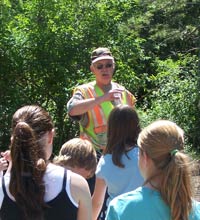Background

What is MnDOT doing as part of the Stormwater Pollution Prevention Program?
MnDOT has the following activities planned to reduce the discharge of pollutants from our storm sewer system to the maximum extent practicable. Each activity corresponds with six control measures.
Public education and outreach
- Develop and distribute educational materials to inform citizens about the impacts polluted stormwater runoff can have on water quality.
- Form partnerships with other MS4’s to more effectively distribute public educational materials.
Public involvement
- Provide opportunity for public participation, an annual online comment period on our website or by contacting us anytime.
Illicit discharge detection and elimination
- Develop a storm sewer system map that identifies MnDOT Metro District’s pipes (at least 24 inches or larger), manholes, catch basins, aprons, ditches, outfalls, ponds, sediment basins and structural pollution control devices.
- Develop and implement a plan to detect and address non-stormwater discharges on our right of way.
- Effectively prohibit non-stormwater discharges into our storm sewer system and implement enforcement procedures and actions.
- Educate employees, volunteers and the public of the hazards from illegal discharges and the improper disposal of wastes.
Construction site discharge controls
- MnDOT follows all National Pollution Discharge Elimination System permit requirements for construction including:
- Implementing proper erosion & sediment controls and controls for other wastes on construction sites of one acre or greater in size
- Implementing procedures for site plan review
- Implementing site inspection and enforcement of control measures with sanctions to ensure compliance
- Implementing procedures for receipt and consideration of information submitted by the public
Post-construction controls for new development
- Permit language which addresses volume, rate and quality of stormwater discharging onto MnDOT Metro right of way will be incorporated into existing permit requirements.
Good housekeeping and pollution prevention
- Training is provided for:
- Erosion and sediment control practices during maintenance activities.
- Proper maintenance practices at facilities (truck stations and buildings) including stockpile areas, storage and hazardous waste areas, material handling areas and fleet operation areas.
- Proper inspection of stormwater systems.
- Illicit discharge detection and elimination.
- Street sweeping practices in the spring of each year will continue
- Anti-icing and de-icing methods will continue to be analyzed and low environmental impact measures will be incorporated where available.
- The vegetation management program will continue.
- Structural pollution control devices, ponds, sediment basins, outfalls, pipes, manholes, catch basins and aprons will continue to be inventoried and inspected.
- Cleaning and repair projects involving pipes, ponds, and structural pollution control devices will continue to occur.
- All inspection, cleaning and repair activities will be recorded and optimum frequencies will be determined.
